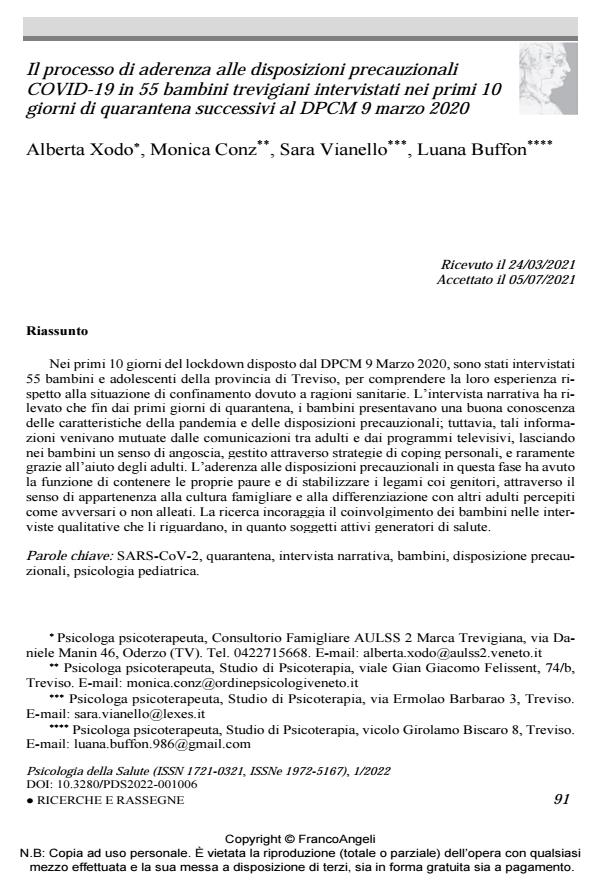Il processo di aderenza alle disposizioni precauzionali COVID-19 in 55 bambini trevigiani intervistati nei primi 10 giorni di quarantena successivi al DPCM 9 marzo 2020
Titolo Rivista PSICOLOGIA DELLA SALUTE
Autori/Curatori Alberta Xodo, Monica Conz, Sara Vianello, Luana Buffon
Anno di pubblicazione 2022 Fascicolo 2022/1
Lingua Italiano Numero pagine 23 P. 91-113 Dimensione file 318 KB
DOI 10.3280/PDS2022-001006
Il DOI è il codice a barre della proprietà intellettuale: per saperne di più
clicca qui
Qui sotto puoi vedere in anteprima la prima pagina di questo articolo.
Se questo articolo ti interessa, lo puoi acquistare (e scaricare in formato pdf) seguendo le facili indicazioni per acquistare il download credit. Acquista Download Credits per scaricare questo Articolo in formato PDF

FrancoAngeli è membro della Publishers International Linking Association, Inc (PILA)associazione indipendente e non profit per facilitare (attraverso i servizi tecnologici implementati da CrossRef.org) l’accesso degli studiosi ai contenuti digitali nelle pubblicazioni professionali e scientifiche
Nei primi 10 giorni del lockdown disposto dal DPCM 9 Marzo 2020, sono stati intervista-ti 55 bambini e adolescenti della provincia di Treviso, per comprendere la loro esperienza ri-spetto alla situazione di confinamento dovuto a ragioni sanitarie. L’intervista narrativa ha rilevato che fin dai primi giorni di quarantena, i bambini presentavano una buona conoscenza delle caratteristiche della pandemia e delle disposizioni precauzionali; tuttavia, tali informazioni venivano mutuate dalle comunicazioni tra adulti e dai programmi televisivi, lasciando nei bambini un senso di angoscia, gestito attraverso strategie di coping personali, e raramente grazie all’aiuto degli adulti. L’aderenza alle disposizioni precauzionali in questa fase ha avuto la funzione di contenere le proprie paure e di stabilizzare i legami coi genitori, attraverso il senso di appartenenza alla cultura famigliare e alla differenziazione con altri adulti percepiti come avversari o non alleati. La ricerca incoraggia il coinvolgimento dei bambini nelle interviste qualitative che li riguardano, in quanto soggetti attivi generatori di salute.
Parole chiave:SARS-CoV-2, quarantena, intervista narrativa, bambini, disposizione precau-zionali, psicologia pediatrica.
Alberta Xodo, Monica Conz, Sara Vianello, Luana Buffon, Il processo di aderenza alle disposizioni precauzionali COVID-19 in 55 bambini trevigiani intervistati nei primi 10 giorni di quarantena successivi al DPCM 9 marzo 2020 in "PSICOLOGIA DELLA SALUTE" 1/2022, pp 91-113, DOI: 10.3280/PDS2022-001006